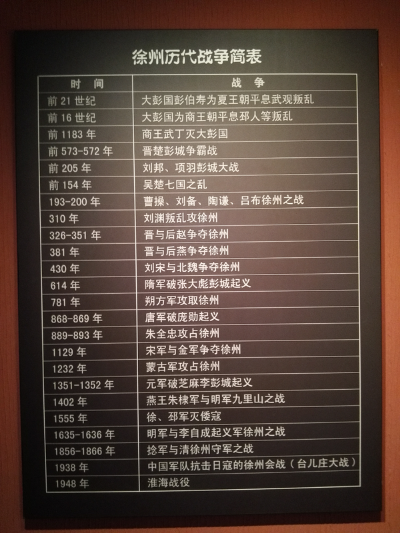Military culture
Since ancient times Xuzhou is an important stronghold in Chinese military and a place contested by all strategies, which is also the only place where great army groups can fight from south to north or from north to south without hindrances. Fighting from north to south, the army can capture Yangzhou. Once Yangzhou falls into enemy’s hands, Nanjing is endangered. If the army fight from south to north, as long as Xuzhou is seized, the whole Central Plains will be spread out like a great chessboard. Then, as long as the great army groups are spread out, they can attack any position as they wish and it is very easy for them to attack cities and strike stockades. Whether Luoyang or Beijing will be nothing difficult.

Naturally to the north of Xuzhou is the flat land, while to the south of it what you see is either the Yangtze River or hills. The landforms are easy to hold but hard to attack. In those years, the Southern Song defended itself relying on the defensive line for nearly two hundred years. Xiangyang and Chongqing are more defensive, where the army of the Southern Song should have resisted Mongolia for so many years without any external assistance. Was it only because the army took death calmly? The landforms played a great role in it. In history, generally political powers in the south would promote their defensive lines northwards, in addition to relying on the hilly terrains, like the Yangtze River, Funiu Mountain and Dabie Mountain, while political powers in the north couldn’t allow armies of southern political powers to march northwards and they would push the defensive line southwards. Thus, the two armies would be stalemated and Xuzhou just lies in the center of where the two parties are stalemated. The military importance of Xuzhou mainly lies in the resisting period between the northern and southern political powers.
As is well known to all, the watershed separating south from north is considered academically the line of Qinling Mountains and Huai River. Therefore, when southern and northern political powers resisted against each other, they would rely on the advantages of favorable geographical positions, so the boundary must be Qinling Mountains and Huai River, which first appeared in the era of Three Kingdoms.
As the old saying goes, to defend the Yangtze River, the army must defend Huai River; to defend Shu Kingdom, the army must defend Hanzhong; to defend Chu, the army must defend Xiangfan. These are the three main defense areas for southern political powers. Correspondingly, northern political powers also have their three main antagonistic defense areas, namely, Guanzhong (probably the area of Shaanxi), Central Plains and Xuzhou. Because of the advantages of cavalries in the north, in fact, northern political powers were in offensive most of the times. Attack is the best defense, which goes without saying that.
The northern area within the ancient Great Wall can be divided into the following areas, Guanzhong, Central Plains, Hebei and Shandong, of which Xuzhou lies in the junctions of Central Plains, Hebei, Shandong and Huaiyang region. Strictly speaking, it should belong to the Central Plains. After all, before the Huai River was in flood in the Song Dynasty, the ancient Xuzhou was also a wonder land. Once southern political powers seized Xuzhou, they could capture Central Plains eastwards, Hebei northwards and Shandong eastwards.
Scenic Spot
-
Huaihai Campaign Monument
Situated south of the Huaihai Campaign Martyrs Memorial Garden, Huaihai Campaign Monument is the famous patriotism education base and red tourist attraction in China, which is chosen as one of 100 “Classic Scenery Spot of Red Tourism”. The newly built Huaihai Campaign Museum is the biggest one of land battles in the world, which has become one of the highlight in Xuzhou’s red tourism relying on… -
Xuzhou Huaihai Battle Martyrs Memorial Tower Scenic Area
The new hall of Huaihai Campaign Museum was approved to be built by the General Office of the CPC in May, 2003 and completed for opening in July, 2007, with the construction area being 25,000 square meters and exhibition area 12,000 square meters, where there are nearly 3,000 pieces of cultural relics, photos and art works on show. The Panorama Hall is located in the center of the Exhibition Hall,… -
Jiuli hill the ancient battlefield
Jiuli hill the ancient battlefield lie in the northwestern suburbs of Xuzhou Jiuli hill, like if Qiulong winding, the modest scenery, deep distant history, stretch unrestrained spiritual, become Gupeng characteristics of a landscape, let people boarding the sing, stop recollections. Historical and cultural city of Xuzhou, surrounded by mountains, easily defensible, since ancient times as a a hotly…